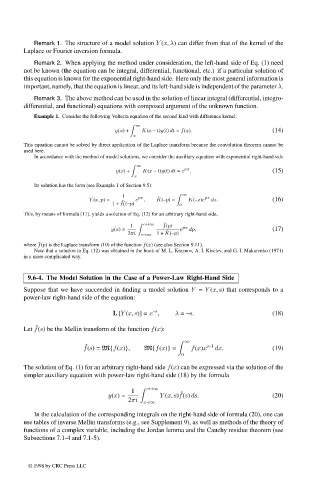Page 499 - Handbook Of Integral Equations
P. 499
Remark 1. The structure of a model solution Y (x, λ) can differ from that of the kernel of the
Laplace or Fourier inversion formula.
Remark 2. When applying the method under consideration, the left-hand side of Eq. (1) need
not be known (the equation can be integral, differential, functional, etc.) if a particular solution of
this equation is known for the exponential right-hand side. Here only the most general information is
important, namely, that the equation is linear, and its left-hand side is independent of the parameter λ.
Remark 3. The above method can be used in the solution of linear integral (differential, integro-
differential, and functional) equations with composed argument of the unknown function.
Example 1. Consider the following Volterra equation of the second kind with difference kernel:
∞
y(x)+ K(x – t)y(t) dt = f(x). (14)
x
This equation cannot be solved by direct application of the Laplace transform because the convolution theorem cannot be
used here.
In accordance with the method of model solutions, we consider the auxiliary equation with exponential right-hand side
∞
y(x)+ K(x – t)y(t) dt = e px . (15)
x
Its solution has the form (see Example 1 of Section 9.5)
1 ∞
Y (x, p)= e px , ˜ K(–p)= K(–z)e pz dz. (16)
1+ ˜ K(–p) 0
This, by means of formula (11), yields a solution of Eq. (12) for an arbitrary right-hand side,
1 c+i∞ ˜ f(p)
y(x)= e px dp, (17)
2πi c–i∞ 1+ ˜ K(–p)
where ˜ f(p) is the Laplace transform (10) of the function f(x) (see also Section 9.11).
Note that a solution to Eq. (12) was obtained in the book of M. L. Krasnov, A. I. Kiselev, and G. I. Makarenko (1971)
in a more complicated way.
9.6-4. The Model Solution in the Case of a Power-Law Right-Hand Side
Suppose that we have succeeded in finding a model solution Y = Y (x, s) that corresponds to a
power-law right-hand side of the equation:
–s
L [Y (x, s)] = x , λ = –s. (18)
ˆ
Let f(s) be the Mellin transform of the function f(x):
∞
ˆ
f(s)= M{f(x)}, M{f(x)}≡ f(x)x s–1 dx. (19)
0
The solution of Eq. (1) for an arbitrary right-hand side f(x) can be expressed via the solution of the
simpler auxiliary equation with power-law right-hand side (18) by the formula
1 c+i∞
ˆ
y(x)= Y (x, s)f(s) ds. (20)
2πi
c–i∞
In the calculation of the corresponding integrals on the right-hand side of formula (20), one can
use tables of inverse Mellin transforms (e.g., see Supplement 9), as well as methods of the theory of
functions of a complex variable, including the Jordan lemma and the Cauchy residue theorem (see
Subsections 7.1-4 and 7.1-5).
© 1998 by CRC Press LLC
© 1998 by CRC Press LLC
Page 481

